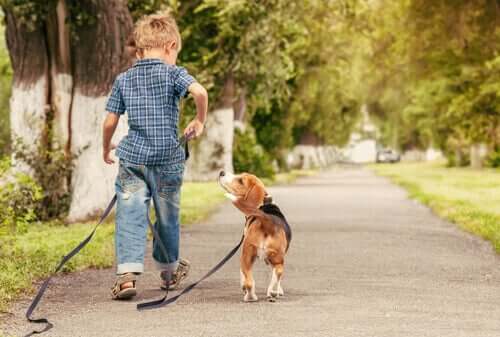My Pet Is Lost! What Should I Do?

Nowadays, pets have become an essential part of the family; they’re loved and pampered. Unfortunately, their naughty and playful side can easily lead them astray. Perhaps you’re among those who at some point have shouted: “My pet is lost! What do I do?”
Here, we’re going to give you ideas on how to bring your unruly friend back home.
My pet is lost: the importance of the tracking chip
Losing a pet is one of the most painful events a family can go through. Concerns regarding whether the pet is well or not causes many to fall into despair and helplessness.
To avoid these very distressing situations, try using a tracking chip instead. With this device, the police, any animal agency or veterinarian can extract contact information and notify you of their whereabouts.

One of the advantages of having these type of devices is their small size; they can be inserted without significant inconveniences. Of course, you should always keep the collar with the updated data, to facilitate recovery in case the pet is lost. This works as a preventive measure.
What to do if your pet is lost
If your pet becomes lost and has the chip installed, but you haven’t heard anything back yet, it’s necessary to resort to other search methods. The best thing will be, then, to immediately plan a way to try to locate it. Some of the things you can do include:
Report it to the authorities
The first thing you should do during the early few hours following the loss is to report it to competent authorities and agencies in the area.
These may include the police, animal shelters, and veterinary care centers. These are people who find homeless animals in the street. Hence the importance of keeping your contact information up to date, if the pet has a tracking chip or collar.
Use social networks
Social networks have become the fastest and most widely available source of communication. This is mainly due to the extensive use they’re given and the number of users that are connected to them. Therefore, if your pet is lost, the ideal thing is to upload a recent photo of the animal to all active groups.
This method is more effective if some of the users live in your community or near the place where the animal disappeared. In some countries, there are special social networks for pet supplies, where such notifications can be posted. With this, you’ll extend the search radius and your chances of success.
Go look for it
During the first hours after you lose your pet, you may find it if you go looking for it in the surrounding areas. It’ll be that much more effective if you ask friends and family for help. This will allow you to spread more ground in less time. Tell them the details to clarify possible doubts about the time and place where your pet was last seen.

Call your pet by name and bring it the cookies and toys that usually catch its attention. If it’s a cat, check tree branches and every small corner where it could fit.
If your pet became lost near your home, return as soon as possible to the place where you last saw it or leave someone there to let you know if it returns. Your pet may have already found its way back.
Put up posters
If hours have passed by and nothing you do works, turn to the oldest technique in the books: put up posters. Prepare posters with recent photos, include contact details and, if you can afford it, a reward. Place them in public spaces; especially in places where there’s a lot of people walking around, such as libraries, public transport stops, avenues, and other spots.
In conclusion, if your pet is lost, there are many things you can do to recover it. Don’t despair. Instead, progressively implement each of the measures discussed above. Only then will your chances of success increase. If days go by, don’t lose hope; many animals are able to find their own way back home.
Nowadays, pets have become an essential part of the family; they’re loved and pampered. Unfortunately, their naughty and playful side can easily lead them astray. Perhaps you’re among those who at some point have shouted: “My pet is lost! What do I do?”
Here, we’re going to give you ideas on how to bring your unruly friend back home.
My pet is lost: the importance of the tracking chip
Losing a pet is one of the most painful events a family can go through. Concerns regarding whether the pet is well or not causes many to fall into despair and helplessness.
To avoid these very distressing situations, try using a tracking chip instead. With this device, the police, any animal agency or veterinarian can extract contact information and notify you of their whereabouts.

One of the advantages of having these type of devices is their small size; they can be inserted without significant inconveniences. Of course, you should always keep the collar with the updated data, to facilitate recovery in case the pet is lost. This works as a preventive measure.
What to do if your pet is lost
If your pet becomes lost and has the chip installed, but you haven’t heard anything back yet, it’s necessary to resort to other search methods. The best thing will be, then, to immediately plan a way to try to locate it. Some of the things you can do include:
Report it to the authorities
The first thing you should do during the early few hours following the loss is to report it to competent authorities and agencies in the area.
These may include the police, animal shelters, and veterinary care centers. These are people who find homeless animals in the street. Hence the importance of keeping your contact information up to date, if the pet has a tracking chip or collar.
Use social networks
Social networks have become the fastest and most widely available source of communication. This is mainly due to the extensive use they’re given and the number of users that are connected to them. Therefore, if your pet is lost, the ideal thing is to upload a recent photo of the animal to all active groups.
This method is more effective if some of the users live in your community or near the place where the animal disappeared. In some countries, there are special social networks for pet supplies, where such notifications can be posted. With this, you’ll extend the search radius and your chances of success.
Go look for it
During the first hours after you lose your pet, you may find it if you go looking for it in the surrounding areas. It’ll be that much more effective if you ask friends and family for help. This will allow you to spread more ground in less time. Tell them the details to clarify possible doubts about the time and place where your pet was last seen.

Call your pet by name and bring it the cookies and toys that usually catch its attention. If it’s a cat, check tree branches and every small corner where it could fit.
If your pet became lost near your home, return as soon as possible to the place where you last saw it or leave someone there to let you know if it returns. Your pet may have already found its way back.
Put up posters
If hours have passed by and nothing you do works, turn to the oldest technique in the books: put up posters. Prepare posters with recent photos, include contact details and, if you can afford it, a reward. Place them in public spaces; especially in places where there’s a lot of people walking around, such as libraries, public transport stops, avenues, and other spots.
In conclusion, if your pet is lost, there are many things you can do to recover it. Don’t despair. Instead, progressively implement each of the measures discussed above. Only then will your chances of success increase. If days go by, don’t lose hope; many animals are able to find their own way back home.
All cited sources were thoroughly reviewed by our team to ensure their quality, reliability, currency, and validity. The bibliography of this article was considered reliable and of academic or scientific accuracy.
- Acero Plazas, V. M.; Gil Tibocha, D. M.; Gutiérrez Vélez, E., & Porto Peralta, G. F. (2014). “Salud Pública, responsabilidad social de la medicina veterinaria y la tenencia responsable de mascotas: una reflexión necesaria”, Revista Electrónica de Veterinaria, 15 (5): 1-18.
- Botero, T. (2013). “Tenencia responsable de mascotas”, Foro de Discusión “Tenencia Responsable de Mascotas”.
- Gómez G., L. F., Atehortua H., C. G., & Orozco Padilla, S. C. (2007). “La influencia de las mascotas en la vida humana”, Revista Colombiana de Ciencias Pecuarias, 20 (3): 377-386.
This text is provided for informational purposes only and does not replace consultation with a professional. If in doubt, consult your specialist.








